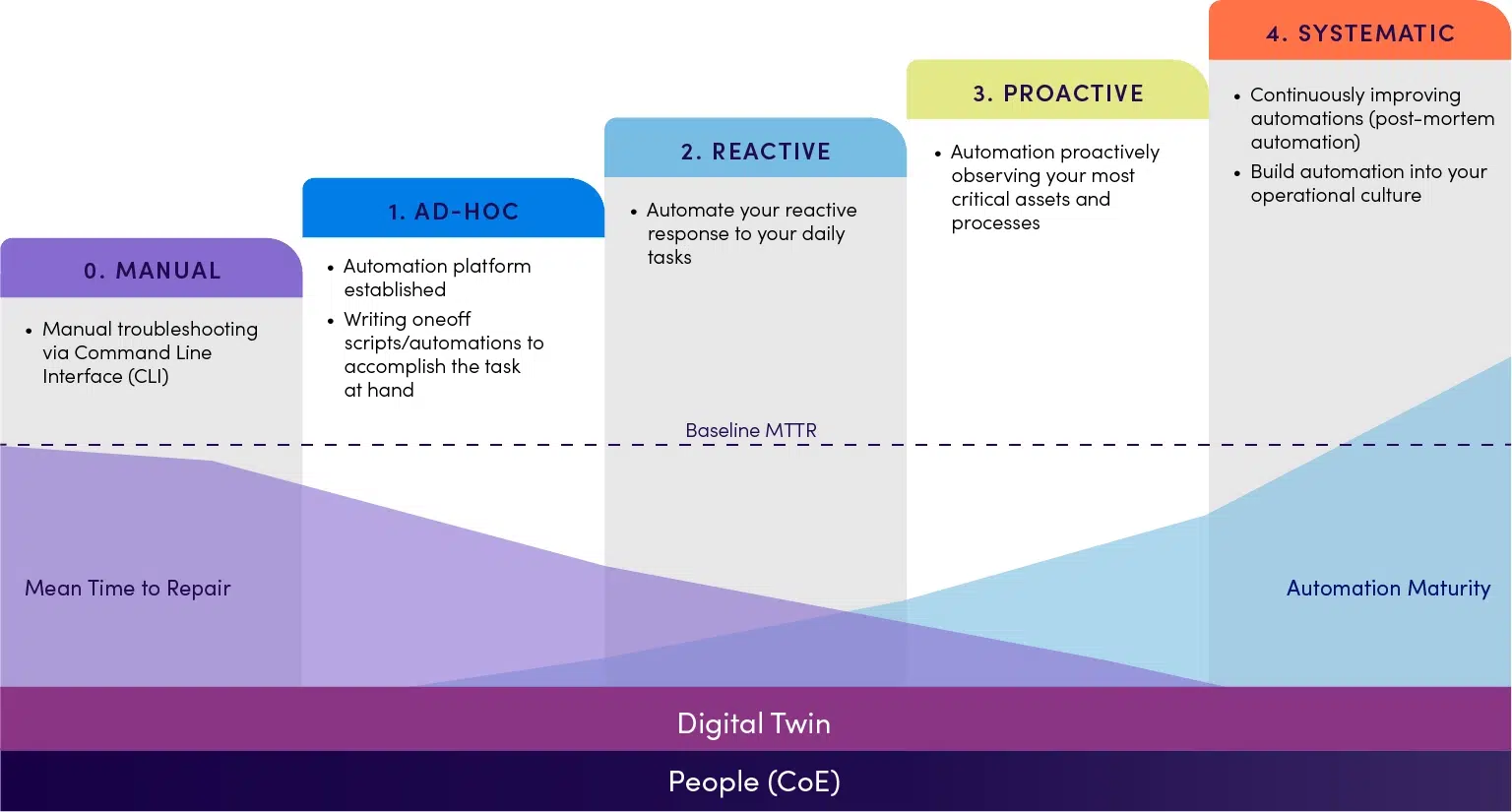10 Unique Ways to Leverage Dynamic Maps
Static network diagrams are a relic of the past. If they’re even created, they’re outdated immediately and offer limited value in today’s complex network environments. What network engineers need are...
Press Release: NetBrain Updates Next-Gen Platform to Deliver AI-Powered Proactive Network Operations >
by Valerie DiMartino Oct 16, 2024
Automation has been a part of technological evolution for a long time, yet its potential is often misunderstood. In today’s fast-paced digital landscape, automation can significantly transform network operations, but understanding how to properly apply and mature these systems is crucial. Let’s explore the levels of automation maturity and how we can advance through them in our own ways.
How do we break down Automation?
The key elements of automation can be described in the way it enhances network observability, diagnosis, change management, and more.
Key features:
How do we define ‘maturity’?

Maturity in automation is a nuanced journey rather than a binary state. It’s about progressing through different levels of workflow enhancement, guided by a strategic North Star. At the foundational level, automation may be used sporadically, such as with ad-hoc tools and reactive documentation. As maturity develops, automation becomes interactive, integrating tools like automated maps and impact analysis to solve problems faster. Further advancement sees automation as part of collaborative workflows, utilizing dashboards and chatbots for regular engineering tasks. Eventually, systems become integrated, triggering machine-to-machine interactions, and ultimately achieving a preventive state where network design is proactive, event-driven, and self-service enabled.
Automation maturity is a journey, not a binary state. Here’s a look at the progression:
Level 1: Ad Hoc
At this stage, automation is sporadic. One-off scripts and reports are used to address immediate issues, such as applying a script to remediate a problem.
Level 2: Reactive
Automation becomes a managed process with reusable task libraries. It’s triggered by incidents to address recurring issues.
Level 3: Proactive
Automation is used to anticipate problems. By gaining deeper network insights, potential issues can be identified before they occur.
Level 4: Systematic
Automation is ingrained in the culture and workflows. Continuous improvement is achieved through new designs and intelligence, with contributions from everyone involved.
Underlay
Focuses on the digital twin and connectivity, managing network devices and their interactions.
Digital Twin
Encompasses four layers: data, topology, path, and intent. It provides a comprehensive view of the network’s architecture and data flow.
2 dimensions:
Involves troubleshooting and changing workflows to enhance service delivery.
Diagnosis Automation
Evolves from ad hoc troubleshooting to systematic analysis and optimization of recurring issues.
Change Automation
Progresses, at the lowest level, from one-off changes to a systematic, protective automation process that continuously improves. Take for example, QoS Configurations. Examines any changes from the original architecture, document variations and integrate them into the golden network model for future validation.
Proactive Observability
Anticipates issues by observing network conditions and addressing them before they escalate.
Observability and Auto-Remediation
Develops from symptom-based monitoring to a platform enriched with context and insights from new designs and learnings.
Overlay
Incorporates AI-enabled interfaces and machine-to-machine interactions for seamless integration.
Facilitates higher-level decision-making as automation moves up the technology stack.
AI and Integration
AI plays a pivotal role in orchestrating automation. It enables seamless integration with external systems and allows for intuitive, human-language interactions. AI simplifies complex automation, providing results in a natural, understandable format.
Advancing Automation Maturity
To advance in automation maturity, organizations must build a common language for automation and define their maturity levels. By applying a structured maturity model, IT can build a proactive strategy for automation.
Automation isn’t just about technology—it’s about evolving processes and integrating intelligence into everyday workflows. By understanding and applying the dimensions of automation maturity, organizations can unlock the full potential of their networks, making more informed decisions and creating resilient, efficient systems.
Static network diagrams are a relic of the past. If they’re even created, they’re outdated immediately and offer limited value in today’s complex network environments. What network engineers need are...
Unraveling Network Mysteries: The Art of Reverse Engineering In networking, reverse engineering doesn’t mean figuring out how something was built and trying to copy it (like the German Enigma machine...
The Gartner IOCS 2024 (IT Infrastructure, Operations & Cloud Strategies) Conference in Las Vegas was an electrifying convergence of thought leadership, groundbreaking technologies, and forward-thinking strategies. This year’s focus on...
We use cookies to personalize content and understand your use of the website in order to improve user experience. By using our website you consent to all cookies in accordance with our privacy policy.